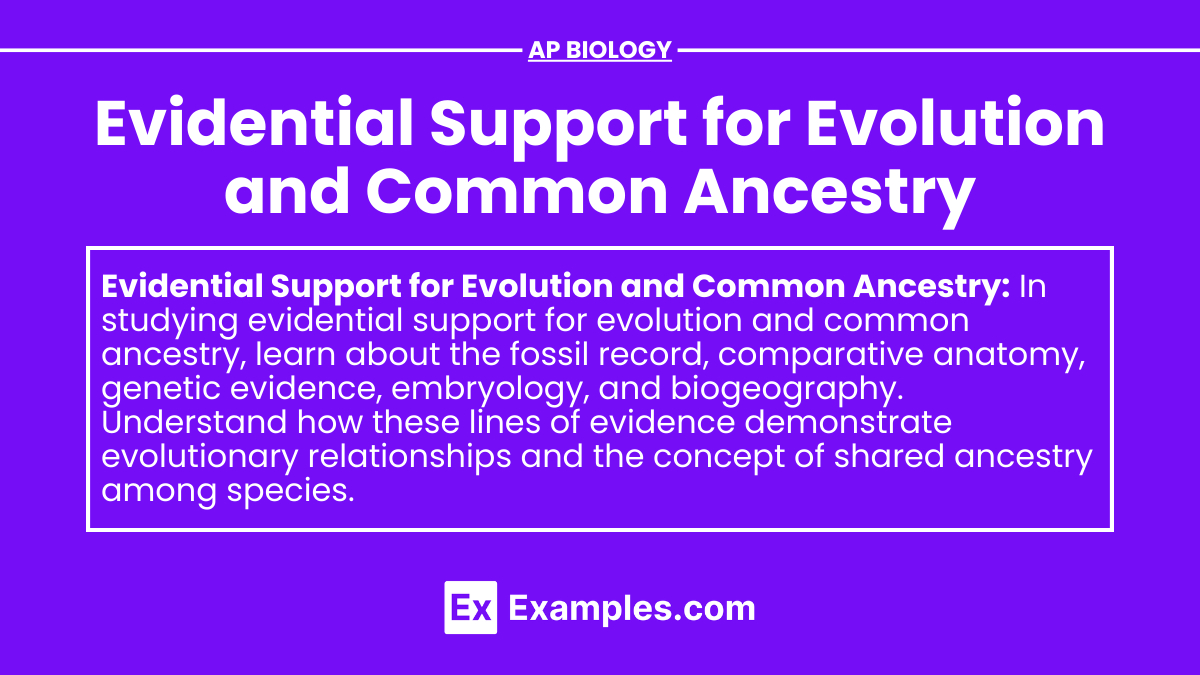In AP Biology, understanding the evidential support for evolution and common ancestry is crucial. This topic encompasses various scientific disciplines, including paleontology, comparative anatomy, molecular biology, and biogeography. The fossil record reveals transitional forms, while comparative anatomy shows homologous and vestigial structures. Molecular biology provides DNA sequence similarities, and biogeography illustrates species distribution patterns. These diverse lines of evidence collectively confirm the evolutionary processes shaping the biodiversity we observe today.
Learning Objectives
In studying evidential support for evolution and common ancestry, you will understand the diverse evidence supporting evolution and common ancestry. You will analyze the fossil record, recognizing transitional fossils and fossil sequences. You will compare anatomical structures to identify homologous and vestigial features. You will explore molecular biology to see DNA sequence similarities and conserved proteins. You will examine biogeography to understand species distribution patterns. By mastering these concepts, you will appreciate how evolutionary processes shape the diversity of life.
Fossil Record
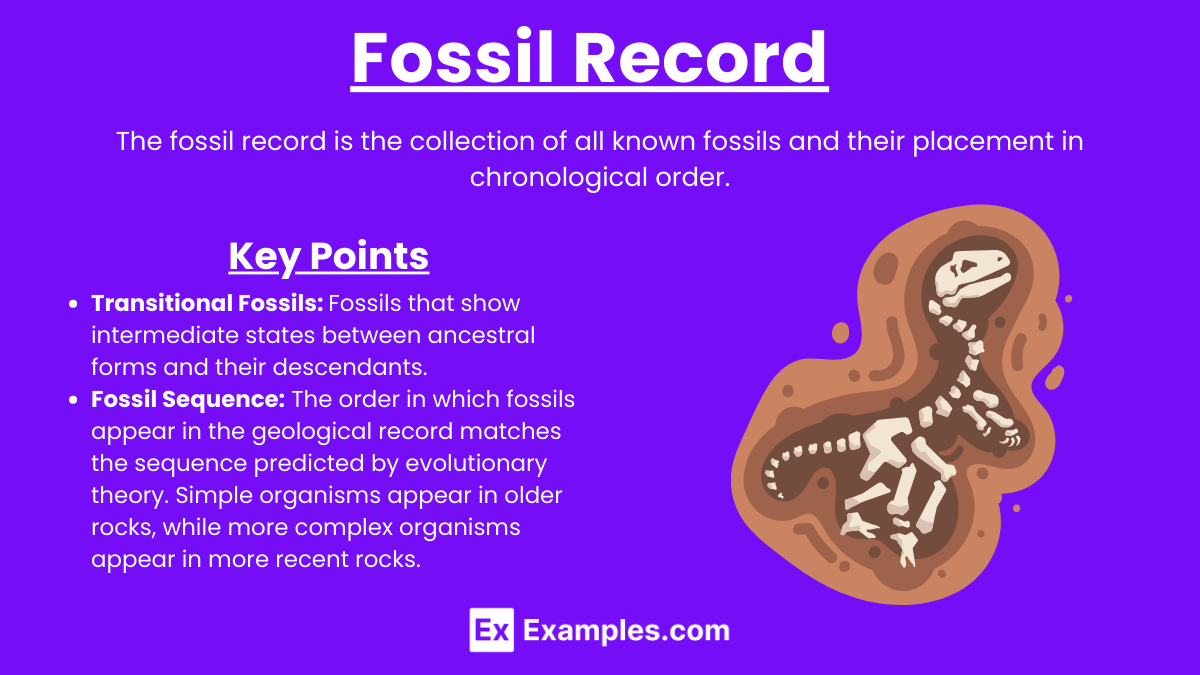
Definition: The fossil record is the collection of all known fossils and their placement in chronological order.
Key Points:
- Transitional Fossils: Fossils that show intermediate states between ancestral forms and their descendants. Examples include Archaeopteryx, which shows features of both dinosaurs and birds, and Tiktaalik, which bridges fish and tetrapods.
- Fossil Sequence: The order in which fossils appear in the geological record matches the sequence predicted by evolutionary theory. Simple organisms appear in older rocks, while more complex organisms appear in more recent rocks.
Comparative Anatomy
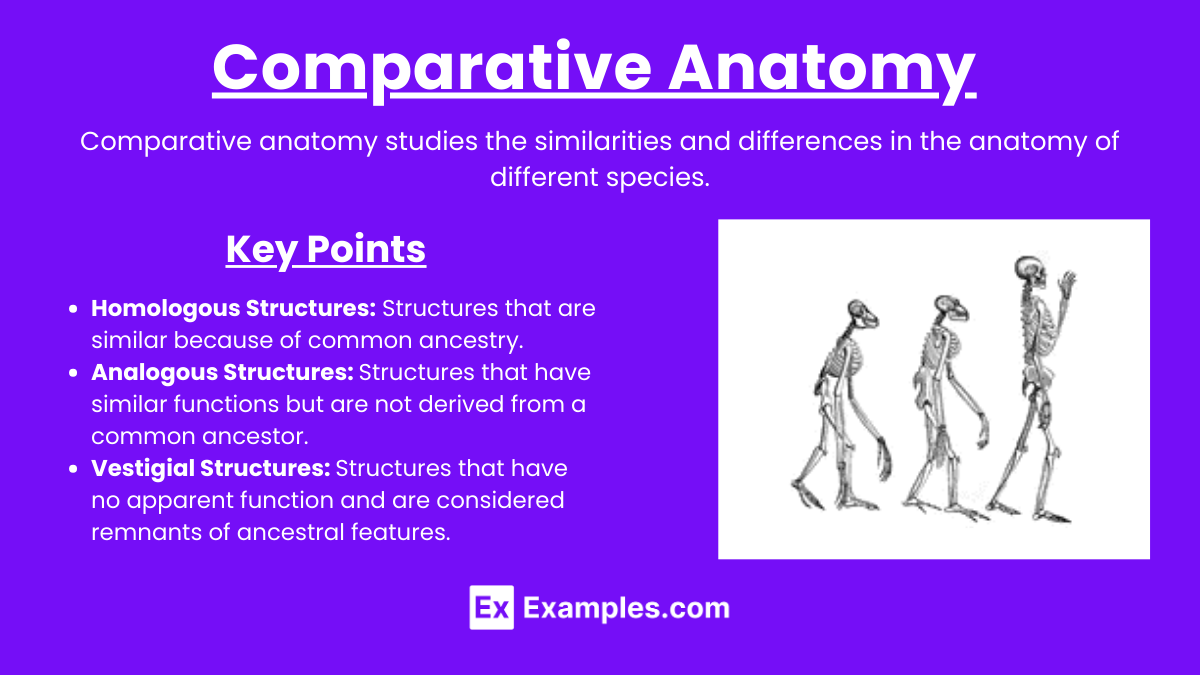
Definition: Comparative anatomy studies the similarities and differences in the anatomy of different species.
Key Points:
- Homologous Structures: Structures that are similar because of common ancestry. For example, the forelimbs of humans, cats, whales, and bats have the same basic bone structure, despite their different functions.
- Analogous Structures: Structures that have similar functions but are not derived from a common ancestor. For instance, the wings of insects and birds.
- Vestigial Structures: Structures that have no apparent function and are considered remnants of ancestral features. Examples include the human appendix and the pelvis in whales.
Molecular Biology
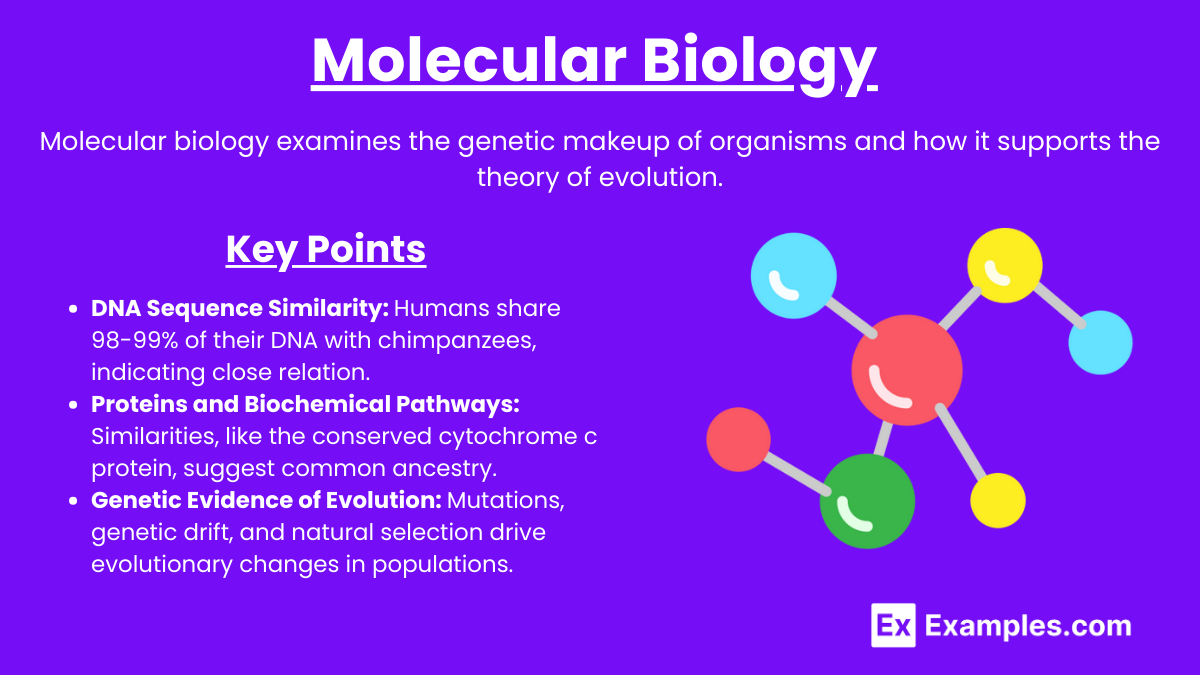
Definition: Molecular biology examines the genetic makeup of organisms and how it supports the theory of evolution.
Key Points:
- DNA Sequence Similarity: Closely related species have more similar DNA sequences. For instance, humans share approximately 98-99% of their DNA with chimpanzees.
- Proteins and Biochemical Pathways: Similarities in proteins and biochemical pathways among different organisms suggest a common ancestry. For example, the cytochrome c protein is highly conserved across different species.
- Genetic Evidence of Evolution: Mutations, genetic drift, and natural selection act on the genetic variation within populations, driving evolutionary change.
Biogeography

Definition: Biogeography is the study of the geographic distribution of species.
Key Points:
- Geographic Distribution: The distribution of species across different continents and islands supports the theory of evolution. For example, the unique species found on the Galápagos Islands helped Charles Darwin formulate his theory of natural selection.
- Continental Drift: The movement of tectonic plates has separated populations, leading to speciation. The distribution of fossils, such as those of the ancient supercontinent Pangaea, supports this.
Embryology
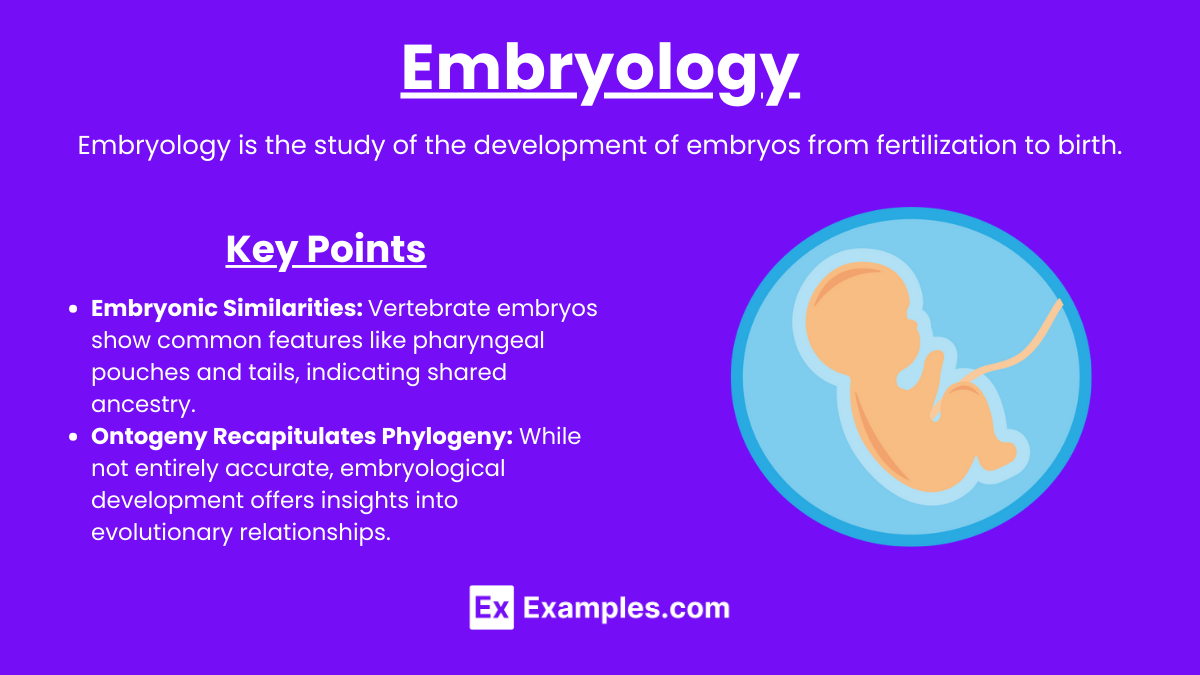
Definition: Embryology is the study of the development of embryos from fertilization to birth.
Key Points:
- Embryonic Similarities: Early stages of embryonic development show remarkable similarities across different species. For instance, vertebrate embryos exhibit pharyngeal pouches and tails, reflecting a common ancestry.
- Ontogeny Recapitulates Phylogeny: Although the idea that an organism’s development (ontogeny) replays its evolutionary history (phylogeny) is not entirely accurate, embryological development does provide insights into evolutionary relationships.
Comparative Genomics
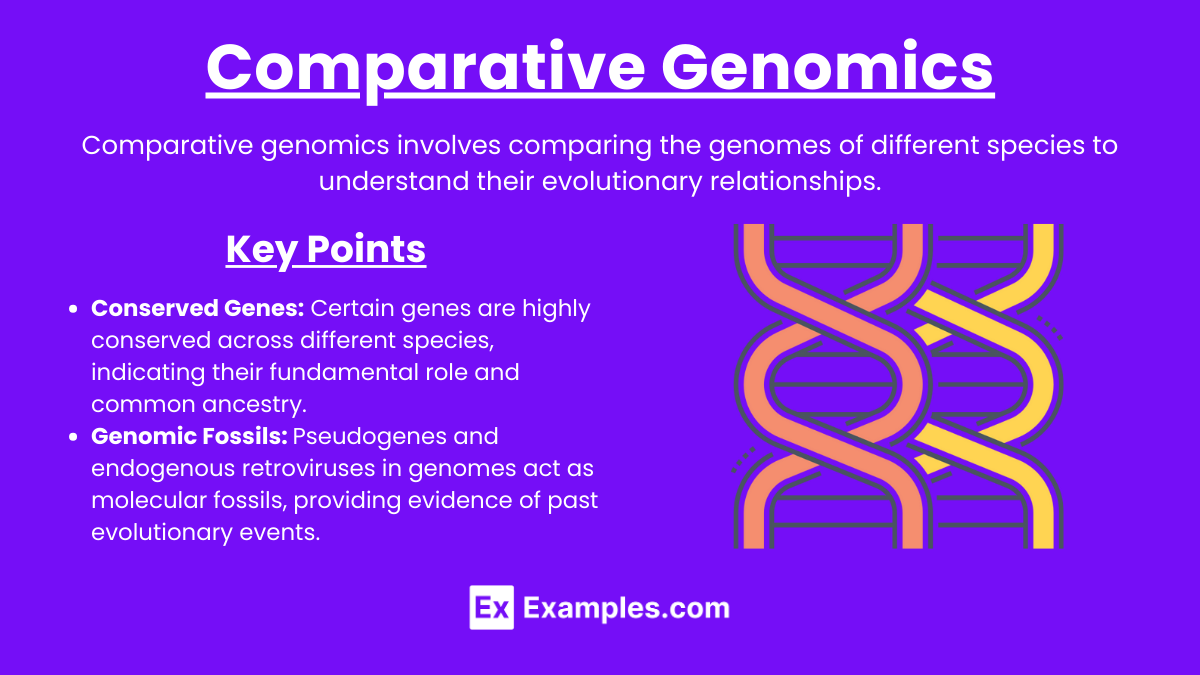
Definition: Comparative genomics involves comparing the genomes of different species to understand their evolutionary relationships.
Key Points:
- Conserved Genes: Certain genes are highly conserved across different species, indicating their fundamental role and common ancestry. For example, the Hox genes that control body plan development.
- Genomic Fossils: Pseudogenes and endogenous retroviruses in genomes act as molecular fossils, providing evidence of past evolutionary events.
Observed Evolutionary Changes
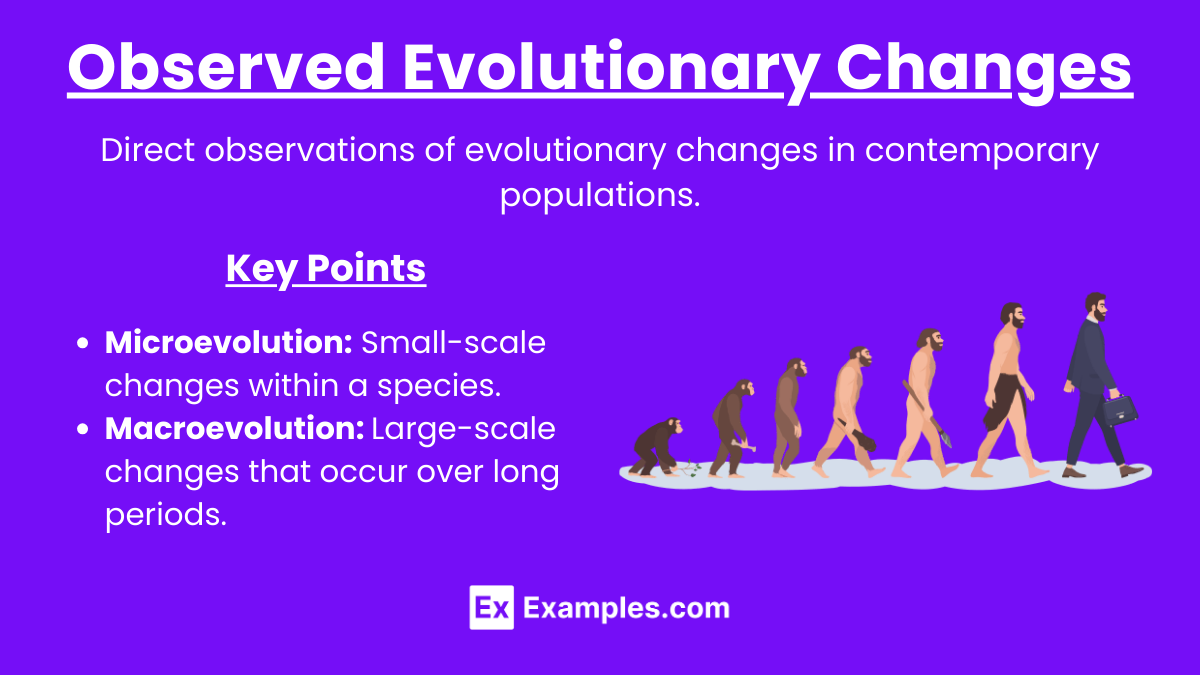
Definition: Direct observations of evolutionary changes in contemporary populations.
Key Points:
- Microevolution: Small-scale changes within a species. Examples include antibiotic resistance in bacteria and the beak size variation in Darwin’s finches.
- Macroevolution: Large-scale changes that occur over long periods. Examples include the speciation events observed in the fossil record and the diversification of life forms
Examples
Example 1: Fossil Record
The fossil record provides chronological evidence of evolution, showing how species have changed over time. Transitional fossils, such as Archaeopteryx, which exhibits both dinosaur and bird characteristics, demonstrate common ancestry and evolutionary transitions.
Example 2: Comparative Anatomy
Comparative anatomy examines the similarities and differences in the structures of different species. Homologous structures, like the forelimbs of humans, bats, and whales, indicate common ancestry despite their different functions.
Example 3: Genetic Evidence
DNA sequencing reveals genetic similarities among species, supporting the idea of common ancestry. For example, humans and chimpanzees share approximately 98-99% of their DNA, indicating a close evolutionary relationship.
Example 4: Embryology
Comparative embryology studies the development of embryos across different species. Similar embryonic stages in vertebrates, such as pharyngeal pouches, suggest a common ancestor.
Example 5: Biogeography
Biogeography examines the geographic distribution of species. The unique species on islands, like Darwin’s finches in the Galápagos, evolved from common ancestors and adapted to different environments, providing evidence for evolution.
Multiple Choice Questions
Question 1: Which type of evidence is provided by homologous structures?
A. Fossil record
B. Comparative anatomy
C. Genetic evidence
D. Biogeography
Answer: B. Comparative anatomy
Explanation: Homologous structures are anatomical features in different species that have similar structures but may serve different functions, indicating common ancestry and are studied in comparative anatomy.
Question 2: What does the high genetic similarity between humans and chimpanzees suggest?
A. They have no evolutionary relationship
B. They share a common ancestor
C. They evolved in the same geographic region
D. They developed similar structures independently
Answer: B. They share a common ancestor
Explanation: The high genetic similarity between humans and chimpanzees suggests that they share a common ancestor, supporting the evidence for evolution through genetic evidence.
Question 3: How do transitional fossils like Archaeopteryx support the theory of evolution?
A. By showing that species do not change over time
B. By providing a direct link between different groups of organisms
C. By indicating that all species appeared simultaneously
D. By proving that current species are the first to exist
Answer: B. By providing a direct link between different groups of organisms
Explanation: Transitional fossils like Archaeopteryx show characteristics of both ancestral and derived groups, providing a direct link and demonstrating the evolutionary transition between different groups of organisms.

